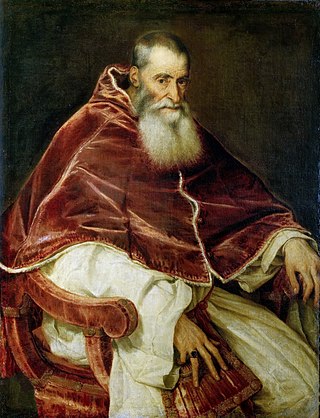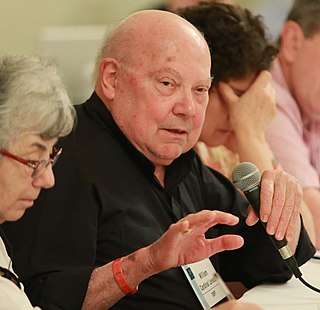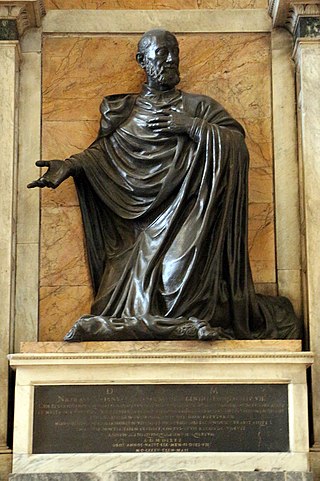
Gasparo Contarini was an Italian diplomat, cardinal, and Bishop of Belluno. He advocated for dialogue with Protestants during the Reformation. Born in Venice, he served as the Republic's ambassador to Charles V during its war with him. He was the first to explain the time discrepancy in the Magellan–Elcano circumnavigation due to Earth's rotation. He participated in diplomatic efforts and reconciliations, and became a cardinal, even though he was initially a layman. Contarini was a leader in the reform movement within the Roman Catholic Church. He played a role in the papal approval of the Society of Jesus (Jesuits). He was also involved in attempts to restore religious unity in Germany.

Pope Paul III, born Alessandro Farnese, was head of the Catholic Church and ruler of the Papal States from 13 October 1534 to his death, in November 1549.

There have been many cases of sexual abuse of children by priests, nuns, and other members of religious life in the Catholic Church. In the late 20th and early 21st centuries, the cases have involved many allegations, investigations, trials, convictions, acknowledgement and apologies by Church authorities, and revelations about decades of instances of abuse and attempts by Church officials to cover them up. The abused include mostly boys but also girls, some as young as three years old, with the majority between the ages of 11 and 14. Criminal cases for the most part do not cover sexual harassment of adults. The accusations of abuse and cover-ups began to receive public attention during the late 1980s. Many of these cases allege decades of abuse, frequently made by adults or older youths years after the abuse occurred. Cases have also been brought against members of the Catholic hierarchy who covered up sex abuse allegations and moved abusive priests to other parishes, where abuse continued.

Stanisław Jan Dziwisz is a Polish prelate of the Catholic Church. He served as Metropolitan Archbishop of Kraków from 2005 until 2016. He was created a cardinal in 2006. He was a long-time and influential aide to Pope John Paul II, a friend of Pope Benedict XVI, and an ardent supporter of John Paul II's beatification.

Jean de Lorraine was the third son of the ruling Duke of Lorraine, and a French cardinal, who was archbishop of Reims (1532–1538), Lyon (1537–1539), and Narbonne (1524–1550), bishop of Metz, and Administrator of the dioceses of Toul, Verdun, Thérouanne, Luçon, Albi, Valence, Nantes and Agen (1538–1550). He was a personal friend, companion, and advisor of King Francis I of France. Jean de Lorraine was the richest prelate in the reign of Francis I, as well as the most flagrant pluralist. He is one of several cardinals known as the Cardinal de Lorraine.

Pier Luigi Farnese was the first Duke of Castro from 1537 to 1545 and the first Duke of Parma and Piacenza from 1545 to 1547. He was the illegitimate son of Cardinal Alessandro Farnese. He became a soldier and participated in the sack of Rome in 1527.

Darío del Niño Jesús Castrillón Hoyos was a Colombian cardinal of the Catholic Church. He was Prefect of the Congregation for the Clergy from 1996 to 2006 and President of the Pontifical Commission Ecclesia Dei from 2000 until his retirement in 2009. He was made a cardinal in 1998.
Ecclesia Dei is the document Pope John Paul II issued on 2 July 1988 in reaction to the Ecône consecrations, in which four priests of the Society of Saint Pius X were ordained as bishops despite an express prohibition by the Holy See. The consecrating bishop and the four priests consecrated were excommunicated. John Paul called for unity and established the Pontifical Commission Ecclesia Dei to foster a dialogue with those associated with the consecrations who hoped to maintain both loyalty to the papacy and their attachment to traditional liturgical forms.
The Pontifical Commission Ecclesia Dei was a commission of the Catholic Church established by Pope John Paul II's motu proprioEcclesia Dei of 2 July 1988 for the care of those former followers of Archbishop Marcel Lefebvre who broke with him as a result of his consecration of four priests of his Society of St. Pius X as bishops on 30 June 1988, an act that the Holy See deemed illicit and a schismatic act. It was also tasked with trying to return to full communion with the Holy See those traditionalist Catholics who are in a state of separation, of whom the Society of Saint Pius X (SSPX) is foremost, and of helping to satisfy just aspirations of people unconnected with these groups who want to keep alive the pre-1970 Roman Rite liturgy.

William Joseph Levada was an American cardinal of the Catholic Church. From May 2005 until June 2012, he served as Prefect of the Congregation for the Doctrine of the Faith under Pope Benedict XVI; he was the highest ranking American in the Roman Curia. He was previously the Archbishop of Portland in Oregon from 1986 to 1995, and then Archbishop of San Francisco from 1995 to 2005. While serving as archbishop, he was criticized for covering up sexual abuse by priests within his jurisdiction. Levada was created a cardinal in 2006 by Benedict XVI.

Odet de Coligny was a French aristocrat, cardinal, Bishop-elect of Beauvais, Peer of France, and member of the French Royal Council. From 1534 he was usually referred to as the Cardinal of Châtillon.

Niccolò Ridolfi was an Italian cardinal.

Girolamo Ghinucci was an Italian papal administrator, diplomat and cardinal in the Roman Catholic Church.

Robert de Lenoncourt was a French bishop, Cardinal, and diplomat. He was the son of Thierry de Lenoncourt, Seigneur de Vignory, Councillor and Chamberlain of the King, and Jeanne de Ville. He had a brother, Henry, Sire de Lenoncourt and Baron of Vignory, a sister named Jacquette, who married Jean d'Aguerre, son of the Governor of Mouzon, and a sister named Nicole, who married Érard du Châtelet. Robert's paternal uncle, also called Robert de Lenoncourt, was Archbishop of Reims.

Reinhard Marx is a German cardinal of the Catholic Church. He serves as the Archbishop of Munich and Freising. Pope Benedict XVI elevated Marx to the cardinalate in a consistory in 2010.
Gregorio Cortese, born Giovanni Andrea Cortese was an Italian cardinal and monastic reformer.
For a number of years after the controversial 1988 consecrations, there was little if any dialogue between the Society of St. Pius X and the Holy See. This state of affairs ended when the Society led a large pilgrimage to Rome for the Jubilee in the year 2000.
Cristoforo Giacobazzi was an Italian Roman Catholic bishop and cardinal.

Niccolò Caetani di Sermoneta (1526–1585) was an Italian Roman Catholic cardinal and bishop.












